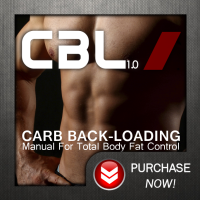There seems to be a massive misconception in the fitness industry regarding how DH’s two main nutritional protocols, Carb Back-Loading™ and The Carb Nite® Solution, are perceived. The way most people see it, you go on Carb Back-Loading if you want to get big and strong (and drop fat), and you opt for Carb Nite if you want to get lean even faster but don’t care about strength gains. In fact, most people I talk to think using Carb Nite for extended periods of time will, in fact, make them weaker.
This is decidedly not the case, as I’ve seen firsthand with my own training, Mark Bell’s training, and with every DH client who’s used Carb Nite. We’ve all gone extremely low-carb for long periods of time, and we’ve all managed to get stronger as we’ve gone along. The problem—if you can even call it a problem—is that Carb Nite works so well and so quickly, that it gives you some things you need to consider, both biomechanically and with regard to the scheduling of your training, before you disregard this as strictly a fat loss plan.
Within a three month period, assuming you’re a male carrying excessive body fat, it’s possible—and even typical—to lose 20-40 pounds of fat. Sounds great, right? Well, yes, but what happens when you take off this much fat is that you’re radically changing the shape of your body. This means that after a while, you’re essentially a whole new person, and you have to take the time to relearn how your body moves.
Timing Is Everything

He may look like he’s jonesin’ for a ham sandwich, but this was taken one day before Jesse smashed previous PRs set when he was 60 lbs heavier.
First, however, you need to consider how an extremely low-carb diet like Carb Nite will affect your training schedule. The first problem people run into with Carb Nite happens when they try to keep everything in their workouts the same during the latter parts of the week in terms of volume and intensity. The longer you’re on Carb Nite, the harder this is going to get. There is, however, a strategy that lets you make up this difference.
With my clients, I really don’t change much until they start to feel the effects of becoming ketogenic, which, if Carb Nite falls on a Sunday, will typically happen by Thursday. This means the majority of your important work for the week will be done on Monday, Tuesday, and Wednesday. The key here is managing your week based on your Carb Nite. If you like having your refeed on Wednesday night, then prepare to perform the lion’s share of your workout week between Thursday and Saturday—after which you’ll taper off your volume and intensity for the rest of the week until your next Carb Nite.
Trust me, you’ll know when you’re ketogenic and it’s time to readjust your training. You’ll feel sluggish, you may have trouble hanging onto thoughts, and you’ll generally be slow and listless. If a client comes into the gym in this state, we’ll cut the volume on his or her planned workout back by at least 10-20% (and often more), focusing on fitting at least two main movements into their hour-long session, taking long rest periods between each set.
Again, to avoid having to go through these on-the-fly adjustments, simply be prepared. For your first three days after your Carb Nite, you’ll be able to take advantage of a serious swell in glycogen, so your schedule should look something like this:
|
MONDAY: |
Higher volume, heavier weight. |
|
TUESDAY: |
Off, or lower volume. |
|
WEDNESDAY: |
Higher volume, heavier weight. |
|
THURSDAY: |
Begin to taper off. |
|
FRIDAY: |
Cleanup work (see below). |
|
SATURDAY: |
Cleanup work. |
There are two things to note about this schedule. First, some people can get away with pushing their volume and intensity into Thursday. These lucky people are few and far between. Experiment and see what works for you. It all depends on when you start feeling the effects of going ketogenic. Next, by “cleanup” work, I’m referring to the type of volume and intensity you’ll be using as you taper off in the days leading into your next Carb Nite. The Shockwave Protocols are the perfect solution for managing volume at this stage of your training week.
Check Your Technique
Now, since strength is your primary concern, you’re going to have to be prepared to adjust everything once you start experiencing the massive fat loss that comes with Carb Nite. When your leverages change, the way you go about lifting the bar needs to change, too. With these changes in your body, you may not necessarily be getting weaker, but your stroke in certain lifts—your bench press and deadlift, for example—will actually get longer, meaning the bar has to travel further to reach its destination.
The idea here is to focus on streamlining your technique to recoup those inches you’re losing, and to perfect the way you go about your lifts instead of relying solely on girth to raise the bar. If you find that your lifts are really starting to suffer, videotape yourself and take a closer look at what’s happening.
One tip we always recommend in our seminars is to look at videos of top lifters on YouTube. The idea is to find one who realistically matches your body type. If you’ve suddenly gone from being a “fat” lifter to being a “skinny” lifter, you can’t continue lifting like a fat guy.
This means you can’t lean on your belt anymore at the bottom of a squat. Instead, you’ll have to stay more upright, lean on your hips, and work on pushing your knees out. With bench pressing, if your weakness has always been at the top of your stroke, and you’re suddenly having problems getting the bar off your chest, it’s because of those lost inches. You’ll have to make that up by playing with your setup, and by gaining some more muscle in your lats to compensate for that added distance.
This also applies to your exercise selection. When you lose body fat at such a rapid clip, it’s wise to simplify your list of exercises. When you’re on Carb Nite, you don’t need to do exotic lifts like high safety-bar squats to a foam block with bands, chains, and weight releasers. Just work on 3-5 main movements per week to use your new form and learn how to move with your new bodyweight and new leverages.
Finally, make absolutely sure you’re downing a high-quality pre- and post-workout shake (covered in detail in Carb Back-Loading™). Incorporate all these tips into your Carb Nite week, and I think you’ll find that gaining strength on an extremely low-carb plan isn’t nearly as hard as you’ve imagined.
Feature Image by: aaronsimscompany









Recent Comments